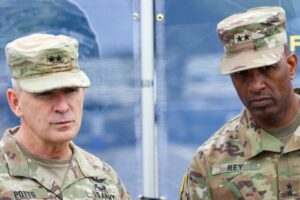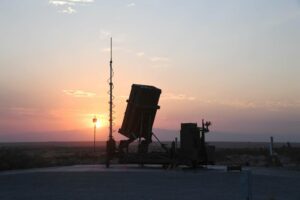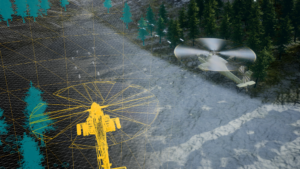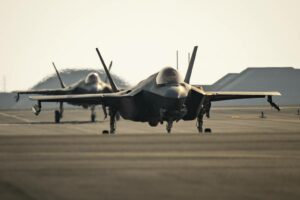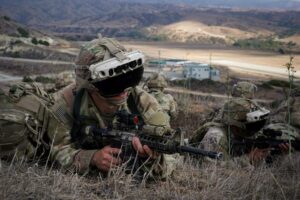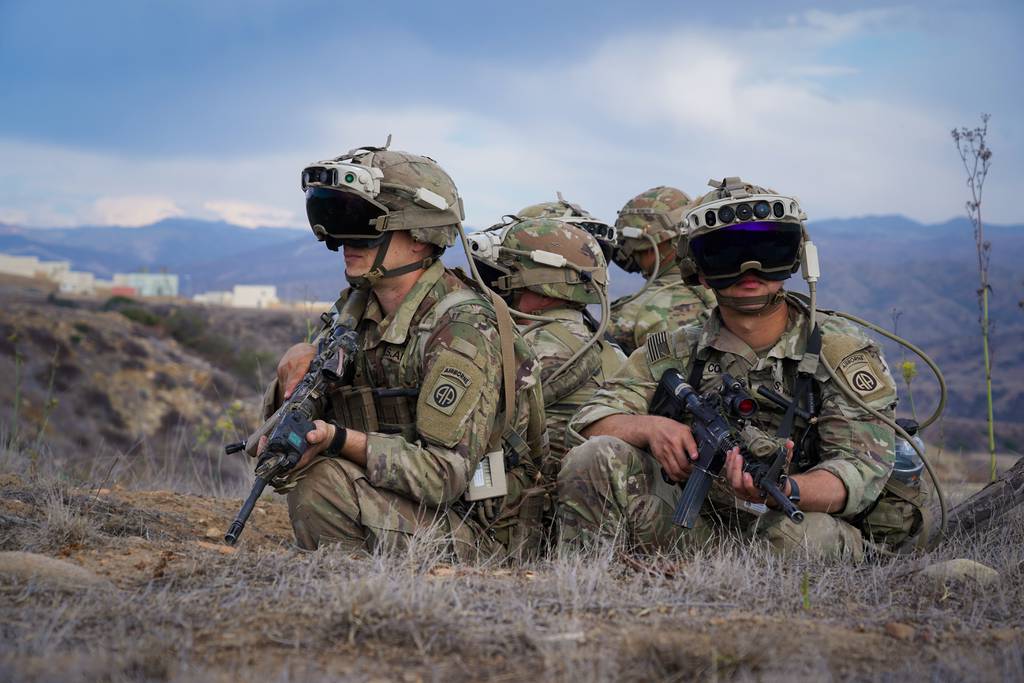
WASHINGTON — The Association of the United States Army held its annual conference Oct. 9-11 in Washington, with defense officials, military personnel and industry representatives gathering to discuss the future force — and what threats it may face from advanced adversaries.
The service is in the midst of a modernization effort that has focused on long-range precision fires; next-generation combat vehicles; future vertical lift aircraft; the network; air and missile defense; and soldier lethality. It is now expanding that focus to positioning, navigation and timing, as well as advanced training technology. But the war in Ukraine has impacted much of the Army’s decisions.
Gen. James Rainey, who leads Army Futures Command, the service’s organization in charge of modernizing the force, said the service needs to adapt its artillery strategy based on both “what’s happening in Ukraine” as well as what U.S. Army Pacific requires from conventional fires.
“Everything we’re seeing in Ukraine [is] about the relevance of precision fires, all the emerging technology, but the big killer on the battlefield is conventional artillery, high-explosive artillery,” he said.
The U.S. Army plans to issue a new conventional fires strategy by the end of the year, he added.
Defense News, Army Times and C4ISRNET covered this and more from the show. Catch up on our top stories from this year’s AUSA conference and read more at defensenews.com/digital-show-dailies/ausa and c4isrnet.com/digital-show-dailies/ausa.
Modernization
Change of plans: US Army embraces lessons learned from war in Ukraine
Expensive, massive tanks destroyed by small and cheap loitering munitions. Drones helping artillery locate targets. A battlefield so flooded with sensors that it’s impossible to stay hidden for long.
Since Russia invaded Ukraine in February 2022, the Army has carefully taken note of these trends. Now those changes are reshaping the service’s plans from acquisition to how to approach formations to reimagining logistics. Already, the Army has rethought its plans to modernize tanks and altering its strategies with drones.
“The character of war is changing,” Army Chief of Staff Gen. Randy George told Defense News in an interview ahead of the Association of the U.S. Army’s annual conference. “It’s changed more in the last couple of years because of the war in Ukraine. And I think it will continue to change at a very rapid pace and we have to have the mindset to change with it.” Click here to read more.
Army’s upcoming artillery strategy has ‘a big menu’ to choose from
Decisions on the way forward for one of the U.S. Army’s top long-range fires priorities — the Extended Range Cannon Artillery program — won’t come until a new conventional fires strategy is complete, the service’s acquisition chief said.
“It really becomes a fiscal year 2025 budget decision, if we were to go in a different direction,” Doug Bush confirmed to Defense News in a recent interview. “I think, though, that the requirement is still there. We still need longer range in a more affordable way, which is an important caveat.”
Of the 24 new Army systems slated to make it into the hands of soldiers by the end of 2023, only the Extended Range Cannon Artillery program might miss that goal, Bush said when the Army unveiled its fiscal 2024 budget request this year. Click here to read more.
The Army’s new chief has a plan and it’s all about warfighting
Gen. Randy George begins his tenure leading the Army as it faces a period of rapid change, competition with adversaries across the globe and a strained force. The new chief of staff intends to fuel that fight by distilling the complex set of challenges facing the force into a singular goal: ensuring the service is the best warfighting organization it can be.
The general was once a private, having enlisted out of his Iowa hometown, but by 1984 he was at the U.S. Military Academy at West Point. Graduating in 1988, the infantry officer first saw combat with the 101st Airborne Division as part of Operation Desert Shield/Desert Storm only two years later.
That operational career has informed how he wants to lead the Army through the coming years amid old and new demands on a smaller Army that’s expected to be everywhere it’s needed when called.
George, 58, talked with Army Times about his four focus areas, the generals he’s tasked with leading those efforts and what he expects from soldiers across the force. Click here to read more.
What’s the firepower like for the Army’s new rifle?
The Army’s new rifle, automatic rifle and fire control provide a more accurate, farther reaching and deadlier combination of weapons than a squad or platoon currently carries.
During a September media event held at Aberdeen Proving Ground in Maryland by Program Executive Office Soldier, participants shot both the Next Generation Squad Weapon XM7 rifle and the XM250 automatic rifle — the Army’s replacements for M4 and M249 Squad Automatic Weapon for the close combat force. That group includes infantry, scouts, combat engineers and special operations forces.
At the event, officials announced a unit in the 101st Airborne Division had received the weapons that week and would undergo initial training on the weapons later in the month, followed by limited-user tests in October. A squad from the 75th Ranger Regiment will also participate in testing the weapons. Click here to read more.
US Army ready to pursue electric light recon vehicle
The U.S. Army is ready to pursue a prototyping program for an electric light reconnaissance vehicle beginning in fiscal 2024, pending funding approval from Congress, the service’s program executive officer for combat support and combat services support told Defense News.
“We’re ready to get working on that program,” Brig. Gen. Luke Peterson said in an interview ahead of the Association of the U.S. Army’s annual conference. “It’ll be a prototyping effort, and we will learn from that to help inform a fully developed capabilities development document.”
The Army already approved an abbreviated capabilities development document for the eLRV, and Peterson’s office has partnered with the Maneuver Center of Excellence at Fort Moore, Georgia, to develop requirements.
Using some funding in FY22 to get started, the program office conducted market research that included purchasing some commercial electric vehicles in order to test them against an operational mission profile, Peterson explained. Click here to read more.
Beyond 2030: How Army Futures Command is adapting its approach
The U.S. Army five years ago established a new four-star command, shifting billions of dollars to fund it and basing it in a tech-centric city.
The goal of Army Futures Command was clear: It needed to disrupt the service’s lengthy record of failure when it came to producing a new modernization program.
As the Army gets closer to its 2030 goal for fielding new weapons, service leaders say the command is here to stay — but will expand its focus. Click here to read more.
Training
21,000 casualties in seven days: The push to update medic training
In a recent corps-level wargame, U.S. Army forces sustained 21,000 casualties in seven days. That’s nearly half the soldiers in a full-strength corps.
“It will take everyone to clear the battlefield as quickly as we can when we’re talking about the scale of 21,000 casualties in corps warfighting,” said Maj. Gen. Michael Talley, head of the Army’s Medical Center of Excellence. “That’s reality. How do you keep going? How do you sustain momentum?”
Talley laid out these challenges the military medical community faces, and what can be done, during a recent Maneuver Warfighter Conference panel at Fort Moore, Georgia. Click here to read more.
Divisions are headed into the dirt
Division staff and the units that support brigade operations will be getting dirty.
Exercises where a commander can simply simulate a water resupply or fueling station for long-range helicopter assaults are great for planning but miss the realities of actual fighting — weather, downed vehicles and the hands-on skills of individual soldiers.
Simulations help but can hardly predict or provide the “friction” of actual combat, or even some aspects of training, Gen. Andrew Poppas, head of Army Forces Command told Army Times.
“That’s a dynamic you have to refine only in the dirt,” Poppas said. Click here to read more.
How a shovel can help with training, plus common mistakes during drill
A company commander’s best tool for surviving the crucible of a combat training center may be a shovel.
Commanders headed for their time “in the box” at any of the major training centers across the Army — from the National Training Center at Fort Irwin, California, to the Joint Multinational Readiness Center in Germany to the Joint Readiness Training Center in Fort Johnson, Louisiana — will need to do a lot of home station preparation and get their soldiers digging.
That’s one of a slew of tips that some current observer controllers/trainers at the centers shared at the recent Maneuver Warfighter Conference on Fort Moore, Georgia, during a session aimed at company commanders heading to the centers. Capt. Joseph White and 1st Sgt. Brandon Robinson, both cadre with the Joint Multinational Readiness Center, said the most significant struggle at their location isn’t related to technology but rather discipline and standards.
“Are your soldiers doing the right thing when you’re not there?” White said. Click here to read more.
‘As long as it takes’: US Army doubles down on Ukraine training goals
Canadian and U.S. Army officials are determined NATO efforts to train Ukrainian forces will last long term, despite uncertainty over whether Congress will continue to fund additional military assistance for Kyiv.
Canadian Brig. Gen. Mason Stalker, the deputy training commander for Security Assistance Group-Ukraine, stressed at the Association of the U.S. Army’s annual conference that dozens of NATO members are contributing to these efforts, even though the future of the United States’ role in the conflict remains unclear. Click here to read more.
Op tempo, training complexity pose risk to aircrews, per aviation boss
A few months ago, the Army’s aviation community appeared to be facing a dire situation.
A series of deadly helicopter crashes killed 14 soldiers between February and April, interrupting one of the safest periods in the Army’s flying history.
That led the service’s leaders to order an Army-wide safety stand down in May — the rare move grounded all non-deployed flying units until they completed a mandatory safety training program led by their commanding generals. The sessions, leaders said, also allowed junior troops and other community members to provide feedback on safety practices and challenges in the community.
Ahead of the Association of the U.S. Army annual meeting, Army Times spoke with aviation branch chief Maj. Gen. Mac McCurry, who commands the aviation schoolhouse and Fort Novosel, Alabama, about the stand down’s findings and ongoing initiatives in Army aviation. Click here to read more.
Personnel
Data powers Army’s return to the ‘lost arts’ of wartime personnel work
Fiscal 2023 proved busy for the Army’s top personnel officials.
A recruiting crisis made it harder to fill the ranks — and project what future forces the service needs and how it can fill those units. A new Army-wide human resources system debuted after multiple delays. And Russia invaded Ukraine.
According to Lt. Gen. Douglas Stitt, the Army’s top personnel officer and leader of its G-1 directorate, these events combine to create a “growth industry” where the service’s personnel pros can apply new technology and tricks to the “lost arts.” Stitt and his senior enlisted adviser, Sgt. Maj. Christopher “Smoke” Stevens, spoke with Army Times at the Pentagon on Sept. 25 ahead of the Association of the U.S. Army’s annual conference. Click here to read more.
The Army’s new fitness program team will come to you
The command rolling out the Army’s new, all-encompassing fitness program has a fresh way to get the program’s expertise inside more units.
If an active duty division commander can dedicate a five-soldier team — comprised of one captain, two senior noncommissioned officers and two junior NCOs — to learning the essentials, the Center for Initial Military Training under Training and Doctrine Command will send cadre to them. Click here to read more.
House moves to strengthen vetting for military financial counselors
A bipartisan duo of House lawmakers has banded together to improve the vetting of financial advisers for service members. The move comes after an Army counselor with undisclosed conflicts of interest with outside brokerage firms allegedly swindled two dozen Gold Star families.
The House in July passed legislation from Reps. Mikie Sherrill, D-N.J., and Don Bacon, R-Neb., that would require the Defense Department verify its roughly 400 military financial advisers are without conflicts of interest by having them submit annual financial disclosures.
Sherrill and Bacon introduced the legislation as an amendment to the fiscal 2024 defense policy bill after a report by The Washington Post detailed how an Army financial counselor, Caz Craffy, allegedly mismanaged a cumulative $750,000 in four families’ life insurance funds by placing the money in the brokerage accounts of firms where he simultaneously worked. Click here to read more.
The inside story of how the Army rethought recruiting
Army Secretary Christine Wormuth knows she — and the Army — can’t control everything in life.
The Army can’t control childhood obesity rates. The Army can’t control the falling rate of applicants medically or legally eligible to enlist. Nor can the service stop seismic shifts in the labor market, or control the falling percentage of veterans, who are traditionally the most influential and trusted advocates for military service among the U.S. population.
But Wormuth, who recently announced sweeping recruiting reforms, is focused on what the Army can control. Click here to read more.
Army’s top NCO talks discipline and why we’re measuring op tempo wrong
“Hold on a second here,” said Sergeant Major of the Army Michael Weimer at the start of a Sept. 29 interview with Army Times. “I’m just going to touch up a little bit.”
An electric razor’s gentle buzz emanated through the phone, followed by hearty laughter. Army Times spoke with Weimer ahead of the Association of the U.S. Army’s annual conference, but the conversation was barely underway before the Army’s top NCO poked fun at himself. Click here to read more.
Industry
GM Defense, Anduril team up on emerging battlefield needs
Tactical trucks producer GM Defense is partnering with unmanned and autonomous systems specialist Anduril Industries to address emerging needs on the battlefield.
The companies agreed on “establishing a framework to collaborate on defense program capture activities,” they said at the Association of the U.S. Army’s annual conference in Washington on Oct. 10.
“The team is focused on delivering autonomy solutions, battery electrification and other new propulsion technologies, as well as those integrating the full range of Anduril technologies onto GM Defense mobility solutions,” they added. Click here to read more.
Teledyne FLIR debuts vehicle for Army equipment carrier competition
Teledyne FLIR is entering the competition for the Army’s light equipment carrier.
The Small Multipurpose Equipment Transport vehicle, or SMET, is intended to carry gear and light payloads to make soldiers in the field more nimble. Four companies competed for the first generation in 2017, and General Dynamics Land Systems won the first two contracts in 2019 and 2020. The program is now entering its second increment.
Teledyne FLIR introduced its prototype, the six-wheeled M2RV, at the Association of the U.S. Army’s annual conference. It comes with 38 square feet of cargo space, more than 2,600 pounds of payload capacity, and the ability to move at speeds exceeding 10 mph, according to the company.
The model has two attached payloads. The first is its new R80D SkyRaider, a 10-pound quadcopter drone. The second is its 280-HDEP surveillance system, mounted on the rear of the platform. Click here to read more.
US Army seeks to drive down costs within hypersonic missile industry
The U.S. Army sees opportunities for industry to drive down the cost of producing hypersonic missiles as it helps to grow the industrial base, which was essentially nonexistent roughly five years ago, according to Chris Mills, the deputy director for the service’s hypersonics project office within the Rapid Capabilities and Critical Technologies Office.
The Army awarded a contract to Leidos subsidiary Dynetics to build the Navy-designed Common Hypersonic Glide Body for both services. Each service will integrate the missile and fine-tune the capabilities based on individual service needs, such as launching from a ground vehicle or a ship. Click here to read more.
Competing robotic vehicles on display after Army signals new approach
The four companies vying for the Army’s robotic combat vehicle program displayed prototypes at this year’s Association of the U.S. Army conference.
The RCV is an unmanned system meant to serve alongside manned units, part of a larger slate of updated ground combatants — the Next Generation Combat Vehicles — the Army is acquiring. Its missions will include ones that would pose a high threat to soldiers, such as approaching enemy forces for intelligence, reconnaissance and surveillance.
McQ, Textron Systems, General Dynamics Land Systems and Oshkosh Defense were selected to compete for the light model of the RCV in late September. The Army’s framework for the program has since changed, though. Click here to read more.
BAE preps adaptable armored vehicle turret for counter-drone missions
BAE Systems hopes a prototype redesign of its new armored vehicle’s turret could one day allow the U.S. Army to rapidly adapt it into an anti-drone weapon.
BAE is now developing the Armored Multi-Purpose Vehicle for the Army as a replacement for the Vietnam-era M113 armored personnel carriers. The company has so far built more than 270 of the tracked, heavily-armored AMPVs, and hundreds more are on the way, according to BAE’s vice president of business development for combat mission systems, Jim Miller. The business official spoke to Defense News on Oct. 9 at the Association of the U.S. Army’s conference in Washington. Click here to read more.
International
US Army moves to pre-position materials in Pacific
The Army is hoping progress made at Talisman Sabre, the joint U.S.-Australian exercise this summer, could open doors for it to position more equipment in the Indo-Pacific region.
The service sees expanding its pre-positioned equipment in the area as part of its contribution to deterring China.
And the Army made headway this summer when it was permitted to permanently keep three company sets of equipment in Australia following Talisman Sabre, Gen. Charles Hamilton, Army Materiel Command commander, told Defense News in an interview ahead of the Association of the U.S. Army’s annual conference. Click here to read more.
US Army embracing remote maintenance beyond Ukraine
The U.S. Army is applying the telemaintenance capability it developed in a parking lot in Poland to its most challenging logistical theater — the Indo-Pacific, according to the head of Army Materiel Command.
“It has been a great enabler to the warfight in Ukraine,” Gen. Charles Hamilton told Defense News in an interview just ahead of the Association of the U.S. Army conference. “It’s one of the game changers in a sense.”
Now, AMC, working with U.S. Army Pacific and the 8th Theater Sustainment Command, is readying to use this telemaintenance capability in the challenging environment of the Indo-Pacific. It will first try it in a variety of exercises, including the Defender series and Talisman Sabre in Australia, Hamilton said. Click here to read more.
Military intervention in Niger unlikely, says Ghana’s top Army officer
A West African union is considering diplomatic options in response to the July coup in Niger that ousted democratically elected President Mohamed Bazoum, the head of Ghana’s Army Staff told Defense News.
But Maj. Gen. Thomas Oppong-Peprah also noted a “military assessment” is underway to examine a possible armed intervention in Niger, a prospect the Economic Community of West African States, or ECOWAS, first floated in August after the bloc’s defense chiefs met in Ghana. Click here to read more.
US Army relies on Pacific allies, exercises to sustain supply lines
U.S. Army commanders overseeing forces in the Indo-Pacific outlined their work with allies and partners in the region to sustain the supply lines that allow the service to maintain forces throughout the broad, diffuse area.
“This mesh network of friends, partners and allies helps us to accomplish the things that the Army needs to have done,” Lt. Gen. Xavier Brunson, who commands the Army’s I Corps, said at the Association of the U.S. Army’s annual conference. “One of those things is we’ve got to build interior lines.” Click here to read more.
US Army’s multidomain task force units could bring in allies, partners
The U.S. Army’s multidomain task force units could see elements that include allies and partners, according to the head of U.S. Army Pacific.
“We’re actually doing some work right now with the third MDTF in Hawaii to create conditions for a combined MDTF,” Gen. Charles Flynn told Defense News on Oct. 9 at the Association of the U.S. Army’s annual conference. “Australia is moving five officers this summer — summer of 2024 — to Hawaii so we can build out a combined element of the multidomain task force”
The Army is also considering how it could include Japan in an MDTF. Click here to read more.
Unmanned tech
Shield AI unveils V-Bat Teams drone swarm tech, with eye to Replicator
California-based defense technology firm Shield AI launched a new drone swarming capability called V-Bat Teams — one it hopes the Defense Department might use for programs such as its Replicator initiative.
V-Bat Teams, which grew out of Shield AI’s experiments with the Air Force’s AFWERX innovation unit that culminated in a demonstration this summer, has at its core the company’s artificial intelligence pilot software dubbed Hivemind. These teams consisting of a handful of V-Bat aircraft are intended to operate autonomously in high-threat environments, without needing instructions or guidance from GPS or communications. Click here to read more.
Kongsberg sending counter-drone network to Ukraine, pitching it to US
Kongsberg is sending its integrated counter-drone system to Ukraine to help guard against incoming Iranian-made loitering munitions, and hopes to convince the U.S. Army and Marine Corps to consider the system for future vehicle programs.
The Norwegian company builds the Common Remotely Operated Weapon Station, or CROWS, used atop U.S. Army vehicles as well as the remote weapon station on the Marine Corps’ Marine Air Defense Integrated System.
But the company sees where its Integrated Combat Solution software, which would tie together multiple vehicles, unmanned systems and sensors, “could change the way we fight, and doctrinally change and improve survivability to our end user,” John Carlsson, the company’s vice president of business development in the United States, told Defense News at the Association of the U.S. Army’s annual conference. Click here to read more.
US Army mulls attack drones, ground robots for Replicator
The U.S. Army could contribute one-way attack drones and ground-based robotics to the Pentagon’s nascent Replicator initiative, which aims to deploy autonomous systems en masse to counter Chinese stockpiles.
Deputy Defense Secretary Kathleen Hicks rolled out the venture in August, calling for thousands of attritable systems in the field in the next 18 to 24 months. Details have been scant regarding sourcing and validation of the systems as well as how the U.S. will dispatch them so quickly.
Army Secretary Christine Wormuth on Oct. 9 said the service has “a number of areas that would be right for Replicator,” including UAVs “of all sizes.” The service is in close coordination with the defense secretary’s office.
“Obviously UAVs, both using them as sensors and as deliverers of payloads, and also defending against them, are key on the battlefield,” she told reporters on the sidelines of the annual Association of the U.S. Army conference in Washington. “Some of the loitering munitions that we have could be candidates for Replicator. And then, finally, perhaps some of our ground robots.” Click here to read more.
Teledyne launches latest Black Hornet nano-drone with upgraded sensors
Teledyne FLIR Defense is betting big on a drone so small it can fit in a soldier’s hand.
The company, part of Teledyne Technologies, rolled out the latest edition of the Black Hornet nano-drone at the Association of the U.S. Army’s annual conference. The Black Hornet 4 is less than a foot long and weighs a fraction of a pound. Click here to read more.
New radar to turn Gray Eagles into anti-drone hunters, says General Atomics
A new multidomain surveillance radar from General Atomics Aeronautical Systems, dubbed Eagle Eye, aims to increase the U.S. Army’s ability to track and shoot down even small drones.
Mike Shortsleeve, vice president of Defense Department strategic development at the firm, said in an interview at the Association of the U.S. Army’s conference in Washington that Gray Eagle 25M drones are now in production with Eagle Eye, a synthetic aperture radar. Click here to read more.
- SEO Powered Content & PR Distribution. Get Amplified Today.
- PlatoData.Network Vertical Generative Ai. Empower Yourself. Access Here.
- PlatoAiStream. Web3 Intelligence. Knowledge Amplified. Access Here.
- PlatoESG. Carbon, CleanTech, Energy, Environment, Solar, Waste Management. Access Here.
- PlatoHealth. Biotech and Clinical Trials Intelligence. Access Here.
- Source: https://www.defensenews.com/recap/ausa/2023/10/12/ausa-highlights-from-the-us-armys-annual-conference/
- :has
- :is
- :not
- :where
- $UP
- 000
- 10
- 14
- 15%
- 16
- 1st
- 2017
- 2019
- 2020
- 2022
- 2023
- 2024
- 2025
- 2030
- 23
- 24
- 25
- 29
- 400
- 58
- 70
- 8th
- 9
- a
- ability
- About
- Academy
- accomplish
- According
- Accounts
- accurate
- acquiring
- acquisition
- across
- active
- activities
- actual
- actually
- adapt
- added
- Additional
- address
- advanced
- adviser
- advocates
- affordable
- African
- After
- against
- ago
- ahead
- AI
- aimed
- aims
- AIR
- aircraft
- Alabama
- All
- allegedly
- allow
- allowed
- alongside
- already
- also
- AMC
- Amid
- among
- an
- and
- Andrew
- announced
- annual
- any
- appeared
- applicants
- Apply
- Applying
- approach
- approaching
- approval
- approved
- April
- ARE
- AREA
- areas
- armed
- Army
- army aviation
- artificial
- artificial intelligence
- Arts
- AS
- aspects
- Assistance
- Association
- At
- attack
- Aug
- AUGUST
- Australia
- Automatic
- autonomous
- autonomous systems
- autonomously
- aviation
- awarded
- base
- based
- battery
- Battlefield
- BE
- because
- becomes
- been
- before
- Beginning
- BEST
- Betting
- between
- Beyond
- Big
- Bill
- billions
- bipartisan
- Bit
- Black
- body
- both
- Branch
- Brandon
- bring
- broad
- brokerage
- budget
- build
- builds
- built
- business
- business development
- busy
- but
- by
- california
- called
- calling
- came
- CAN
- candidates
- capabilities
- capability
- Capacity
- capture
- Career
- carefully
- Cargo
- carriers
- carry
- Catch
- Center
- Center of Excellence
- Centers
- challenges
- challenging
- change
- changed
- Changes
- changing
- character
- charge
- Charles
- cheap
- chief
- China
- chinese
- Choose
- Chris
- Christine
- Christopher
- City
- clear
- Close
- closer
- collaborate
- combat
- combination
- combine
- combined
- come
- comes
- coming
- commercial
- Common
- Communications
- community
- Companies
- company
- Company’s
- compete
- competed
- competition
- complete
- Completed
- complex
- complexity
- Comprised
- conditions
- Conduct
- conducted
- Conference
- CONFIRMED
- conflict
- conflicts
- Conflicts of Interest
- Congress
- Consider
- considering
- Consisting
- continue
- contract
- contracts
- contribute
- contributing
- contribution
- control
- conventional
- Conversation
- convince
- coordination
- Core
- Cost
- Costs
- could
- Counter
- Couple
- covered
- create
- crisis
- critical
- Current
- Currently
- day
- Days
- debuted
- Debuts
- decision
- decisions
- dedicate
- Defending
- Defense
- Defense Department
- delays
- delivering
- demands
- Department
- deploy
- deputy
- DESERT
- Despite
- destroyed
- detailed
- details
- determined
- develop
- developed
- developing
- Development
- different
- digital
- dire
- direction
- Director
- dirt
- discipline
- Disclosures
- discuss
- Dispatch
- Display
- displayed
- Disrupt
- Division
- do
- document
- does
- doing
- dollars
- don
- done
- doors
- double
- doubles
- doug
- douglas
- down
- dozen
- dozens
- drive
- drone
- Drones
- dubbed
- duo
- during
- dynamic
- dynamics
- each
- Economic
- edition
- effort
- efforts
- elected
- Electric
- electric vehicles
- element
- elements
- eligible
- Embraces
- embracing
- emerging
- Emerging Technology
- enabler
- end
- Engineers
- ensuring
- entering
- Environment
- environments
- equipment
- essentially
- essentials
- established
- Even
- Event
- events
- everyone
- everything
- everywhere
- examine
- Excellence
- executive
- Executive Officer
- Exercise
- Expand
- expanding
- expected
- expects
- experiments
- expertise
- explained
- eye
- Face
- faces
- facing
- Failure
- Falling
- false
- families
- far
- February
- feedback
- Feet
- few
- field
- fight
- fighting
- fill
- Finally
- financial
- findings
- Fire
- fires
- Firm
- firms
- First
- First Generation
- Fiscal
- fit
- fitness
- five
- flooded
- flying
- Focus
- focused
- followed
- following
- Foot
- For
- Force
- Forces
- Fort
- Forward
- four
- fraction
- Framework
- fresh
- friends
- from
- Fuel
- full
- fully
- fun
- fund
- funding
- funds
- future
- Futures
- game
- gathering
- Gear
- Gen
- General
- generation
- gentle
- George
- Georgia
- Germany
- get
- getting
- Ghana
- globe
- GM
- Go
- goal
- going
- Gold
- got
- gps
- gray
- great
- grew
- Ground
- Group
- Grow
- Guard
- guidance
- had
- Half
- Hamilton
- hand
- handful
- Hands
- hands-on
- Happening
- harder
- Have
- having
- hawaii
- Hawk
- he
- head
- headed
- Heading
- Held
- helicopter
- helicopters
- help
- helping
- helps
- here
- Hidden
- High
- highlights
- his
- history
- Home
- hopes
- hoping
- House
- How
- How To
- http
- HTTPS
- human
- Human Resources
- Hundreds
- i
- if
- images
- impacted
- important
- impossible
- improve
- in
- include
- included
- includes
- Including
- Incoming
- Increase
- increment
- individual
- industrial
- industries
- industry
- Influential
- inform
- informed
- initial
- Initiative
- initiatives
- Innovation
- inside
- Inside Story
- instructions
- insurance
- integrate
- integrated
- Integrating
- Intelligence
- intended
- intends
- interest
- interior
- intervention
- Interview
- into
- introduced
- Iowa
- issue
- IT
- ITS
- james
- Japan
- Jim
- John
- Johnson
- joint
- jpg
- July
- just
- Keep
- Key
- knows
- labor
- labor market
- Land
- larger
- Last
- Late
- later
- latest
- launch
- launched
- launches
- launching
- lawmakers
- lead
- leader
- leaders
- leading
- Leads
- LEARN
- learned
- learning
- Led
- legally
- Legislation
- less
- Lessons
- Lessons Learned
- Life
- light
- like
- lines
- little
- location
- logistics
- Long
- longer
- Lot
- Louisiana
- mac
- made
- maintain
- maintenance
- major
- make
- mandatory
- March
- Marine
- Market
- market research
- Maryland
- Mason
- massive
- materials
- May..
- mean
- meant
- measuring
- Media
- medical
- meeting
- Members
- mesh
- Mesh network
- met
- Michael
- might
- Military
- Miller
- Mindset
- miss
- missiles
- Mission
- missions
- mistakes
- mobility
- model
- modernization
- modernize
- modernizing
- Mohamed
- Momentum
- money
- Month
- months
- more
- most
- move
- moves
- moving
- much
- multinational
- multiple
- nascent
- National
- Navigation
- nearly
- Need
- needed
- needing
- needs
- network
- New
- new Chief
- news
- next
- next-generation
- nimble
- nonexistent
- nor
- Norwegian
- note
- noted
- now
- number
- Obesity
- Oct
- october
- of
- Office
- Officer
- officers
- official
- Officially
- officials
- Old
- on
- once
- ONE
- ones
- ongoing
- only
- OP
- open
- operate
- operated
- operation
- operational
- Operations
- opportunities
- Options
- or
- order
- organization
- Other
- our
- out
- outlined
- outside
- over
- overseeing
- Pace
- Pacific
- panel
- parking
- part
- participants
- participate
- partnered
- partnering
- partners
- passed
- pending
- pentagon
- per
- percentage
- perhaps
- period
- periods
- permanent
- permanently
- Personnel
- Peterson
- phone
- pilot
- pitching
- placing
- plan
- planning
- plans
- platform
- plato
- Plato Data Intelligence
- PlatoData
- plus
- Point
- Poland
- policy
- population
- position
- positioning
- possible
- Post
- pound
- pounds
- powers
- practices
- Precision
- predict
- preparation
- president
- private
- producer
- producing
- Product
- Production
- Profile
- Program
- Programs
- Progress
- project
- propulsion
- PROS
- prospect
- prototype
- prototypes
- prototyping
- proved
- provide
- proving
- purchasing
- pursue
- Push
- quickly
- radar
- range
- ranks
- rapid
- rapidly
- RARE
- Rate
- Rates
- rather
- reaching
- Read
- Readiness
- ready
- Readying
- realities
- Reality
- really
- received
- recent
- recently
- record
- recruiting
- redesign
- refine
- regarding
- region
- reimagining
- related
- relevance
- remains
- remote
- replacement
- report
- Representatives
- request
- require
- requirement
- Requirements
- requires
- research
- Resources
- response
- return
- right
- Risk
- robotics
- robots
- Role
- Rolled
- Rolling
- roughly
- Russia
- s
- safest
- Safety
- Said
- saw
- say
- says
- Scale
- Second
- secretary
- security
- see
- seeing
- Seeks
- sees
- seismic
- selected
- send
- sending
- senior
- sense
- sensors
- sept
- Sept. 25
- September
- Series
- serve
- service
- Services
- session
- sessions
- set
- Sets
- seven
- shared
- she
- Shield
- SHIFTING
- Shifts
- Shoot
- shot
- show
- showcasing
- signals
- significant
- simply
- simultaneously
- since
- singular
- situation
- Size
- sizes
- skills
- Slate
- small
- smaller
- So
- so Far
- Software
- solution
- Solutions
- some
- Sourcing
- Space
- special
- specialist
- speeds
- square
- Staff
- stand
- standards
- Star
- start
- started
- States
- station
- stay
- sterling
- Still
- Stop
- Stories
- Storm
- Story
- Strategic
- strategies
- Strategy
- Strengthen
- Struggle
- submit
- subsidiary
- such
- summer
- supply
- support
- surveillance
- sustained
- Swarm
- synthetic
- system
- Systems
- Take
- taken
- talking
- Talks
- Tanks
- targets
- Task
- task force
- team
- teams
- tech
- Technologies
- Technology
- Tempo
- term
- test
- Testing
- tests
- than
- that
- The
- The Area
- The Future
- the joint
- The Washington Post
- Theater
- their
- Them
- then
- There.
- These
- they
- thing
- things
- think
- Third
- this
- this year
- those
- though?
- thousands
- threat
- threats
- three
- Through
- throughout
- TIE
- time
- times
- timing
- tips
- to
- together
- told
- tool
- top
- top stories
- touch
- track
- traditionally
- Train
- Training
- training centers
- transport
- Trends
- Trucks
- true
- trusted
- try
- TURN
- two
- u.s.
- Ukraine
- ukraine war
- Ukrainian
- Uncertainty
- unclear
- under
- undergo
- Underway
- union
- unit
- United
- United States
- units
- unlikely
- until
- unveiled
- Unveils
- upcoming
- Update
- updated
- upgraded
- upon
- us
- us army
- use
- used
- User
- using
- validation
- variety
- vehicle
- Vehicles
- venture
- verify
- vertical
- very
- Veterans
- vice
- Vice President
- Video
- wants
- war
- War in Ukraine
- was
- washington
- washington post
- Water
- Way..
- we
- Weapons
- Weather
- week
- weighs
- WELL
- were
- West
- What
- when
- whether
- which
- white
- WHO
- why
- will
- with
- within
- without
- Won
- Work
- worked
- working
- would
- year
- years
- you
- Your
- zephyrnet

